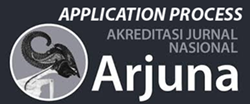Analysis of Melodic Intonation Therapy (MIT) on Speech Ability in Stroke Patients with Aphasia at Srondol Health Center
DOI:
https://doi.org/10.59653/jhsmt.v2i03.974Keywords:
stroke, apasia, melodic intonation terapiAbstract
The Irreversible brain disorders that cause sequelae in the form of motor aphasia or speech disorders which are mostly clinical manifestations in post-stroke patients cause inability to move, speech problems, perspective, because there are problems with brain function. Melodic Intonation Therapy (MIT) is the development of music as a therapeutic medium to improve language skills that use musical elements (intonation and beats) as therapy to improve language skills for people with aphasia. The purpose of this study is to analyze Melodic Intonation Therapy (MIT) on Speech Ability in Stroke Patients With Aphasia with the research stage based on field research in the Srondol community who experienced Stroke with speech difficulties/Aphasia. This research method uses an experimental quasy with a pre-post test with control group design with a sample of 30 respondents with the results of speech development of aphasia patients, international publications, and guidelines for the management of Melodic Intonation Therapy (MIT) in Stroke Patients with Aphasia. Based on the results of the study, it was found that patients who experienced stroke of the families of stroke patients supported him because family support was very important to maintain and maximize physical and cognitive recovery.
Downloads
References
Amila. (2022). Effect of Augmentative and Alternative Communication (AAC) on Functional Communication Ability and Depression of Stroke Patients with Motor Aphasia at Garut, Tasikmalaya, and Banjar Hospitals. University of Indonesia.
Astriani NMDY, D. P. (2019). AIUEO Therapy on Speech Ability (Motor Aphasia) in Stroke Patients. J Telenursing, 1(2):396–405.
Benjamin, E. J. (2017). Update: A Report From the American Heart Association. Heart Disease and Stroke Statistics.
Cahyaningtyas, N. N. (2022). Family Nursing Care with Physical Mobility Disorders in Non-Hemorrhagic Stroke Patients at the Jetis Health Center, Blora City. Repository Poltekkes Semarang, http://repository.poltekkes-smg.ac.id/index.php?p=show_detail&id=33079.
Damanik. (2018). The Relationship between Hypertension Patients' Knowledge about Stroke and Stroke Prevention Behavior at Helvetia Health Center Medan. 1(1), 73–84.
Dickey, L. A. (2020). Incidence and Profile of Inpatient Stroke Induced Aphasia in Ontario. Archives of Physical Medicine and Rehabilitation 91 Canada.
Ghofir, A. (2020). Management of Stroke and Other Vascular Diseases. UGM Press: https://books.google.co.id/books?id=TTUWEAAAQBAJ .
Hutagalung, M. S. (2021). Getting to Know Stroke and the Characteristics of Haemorrhagic and Non-Haemorrhagic Stroke Sufferers: A Complete Guide to Stroke. Nusamedia: https://books.google.co.id/books?id=kqNsEAAAQBAJ.
Indrawati, L. S. (2019). Care Yourself Stroke. Penebar Plus. https://books.google.co.id/books?id=SX_wCwAAQBAJ.
Irianto, K. (2021). Understand various kinds of diseases. Alphabeta.
Junaidi, I. (2021). Stroke, Beware of the Threat. Yogyakata: Offset., Andi.
Khayudin. (2022). Stroke Nursing Care for students and professional nurses. Guepedia, https://books.google.co.id/books?id=cO9ZEAAAQBAJ.
Kyrozis, A. e. (2019). Incidence and Predictors of post-stroke aphasia : The Arcadia Stroke Registry. European Journal of Neurology, 16 (6), pp.733-739.
Lemone, P. B.-J.-s. (2020). Nursing : Critical Thinking in Client Care. French Forest, N. S.W: Pearson Australia.
Lumbantobing, S. (2021). Clinical neurology physical and mental examination . FKUI Publisher Center.
Marinelli, C. V. (2022). Different Cognitive Profiles of Patients with Severe Aphasia. Behavioural Neurology, 1–15. https://doi.org/10.1155/2017/3875954.
Puspitasari, D. (2012). The Effect of AIUEO Therapy on Communication Skills in Post-Stroke Patients in Pontianak City. Journal of Nursing, 1 (3), 1-2.
Rachman, R. (2021). Implementasi Case Based Reasoning Mendiagnosa Penyakit Stroke Menggunakan Algoritma Probabilistic Symmetric. Jurnal Informatika, 8(1), 10–16. https://doi.org/10.31294/ji.v8i1.8563.
Rachmawati, D. M. (2022). Differences in risk factors for stroke in the elderly and adolescents. Bali Medika Journal, 9(3), 207–221. https://doi.org/10.36376/bmj.v9i3.281.
Rowe, e. a. (2018). Save your Life: Overcoming the 9 deadliest diseases. Allen & Unwin.
Seniow. (2019). The Relationship Between Non-Linguistic Cognitive Deficits and Language Recovery in Patients with Aphasia. Journal of the Neurological Sciences, 283 (1-2) : 91-94 https://doi.org/10.1016/J.Jns.2009.
Seniow, J. M. (2019). The Relationship Between Non-Linguistic Cognitive Deficits and Language Recovery in Patients with Aphasia. Journal of the Neurological Sciences, 283 (1-2) : 91-94 https://doi.org/10.1016/J.Jns.2009.
Sofiatun I, K. S. (2015). The Effectiveness of AIUEO Therapy and The Token Test Therapy on the Speaking Ability of Stroke Patients with Motor Aphasia at Mardi Rahayu Kudus Hospital. 3(2):230–8.
Sunusi, G. M. (2019). Analisis Mean Platelet Volume (MPV), Platelet Distribution Width (PDW), dan Jumlah Trombosit pada Stroke Hemoragik dan Non Hemoragik. Indonesian Journal Of Clinical Pathology and Medical Laboratory, 25(2), 202.
WHO, W. H. (2018). Global Health Estimates. Global Health Observatory (GHO). Swiss.
Wiarawan. (2019). Stroke Rehabilitation in Primary Health Services. Smf Medical Rehabilitation Fatmawati Hospital. Maj Kedokteran Indonesia, 59 (2).
Zumbansen, A. I. (2022). Melodic Intonation Therapy: Back to Basics for Future Research. Frontiers in Neurology 5, https://doi.org/10.3389/fneur.2014.00007.
Downloads
Published
How to Cite
Issue
Section
License
Copyright (c) 2024 Sherly Metasari, Elisa

This work is licensed under a Creative Commons Attribution-ShareAlike 4.0 International License.
Authors who publish with this journal agree to the following terms:
- Authors retain copyright and grant the journal right of first publication with the work simultaneously licensed under a Creative Commons Attribution-ShareAlike that allows others to share the work with an acknowledgement of the work's authorship and initial publication in this journal.
- Authors are able to enter into separate, additional contractual arrangements for the non-exclusive distribution of the journal's published version of the work (e.g., post it to an institutional repository or publish it in a book), with an acknowledgement of its initial publication in this journal.
- Authors are permitted and encouraged to post their work online (e.g., in institutional repositories or on their website) prior to and during the submission process, as it can lead to productive exchanges, as well as earlier and greater citation of published work (See The Effect of Open Access).
























